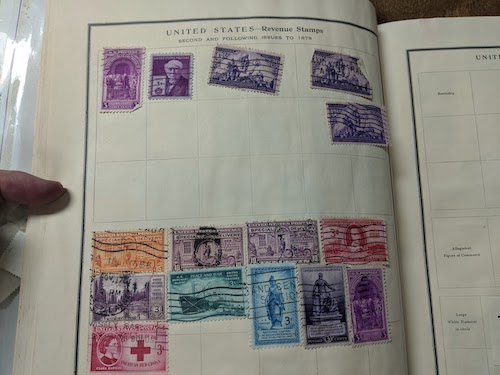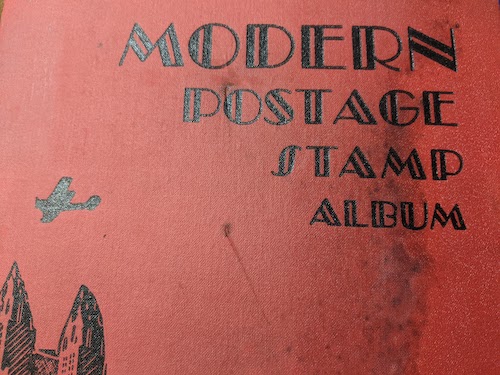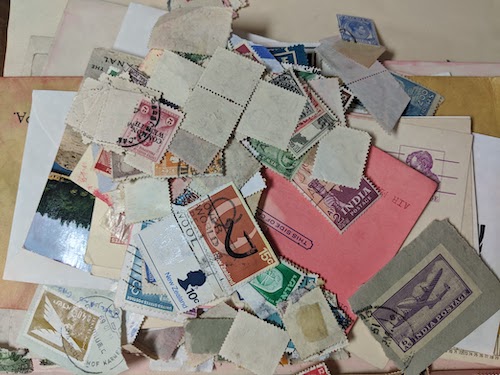Oakton Coins & Collectibles buys stamp collections.
If you inherited a stamp collection, you can bring it in for a free appraisal. Stamp collecting can be a difficult hobby to figure out for inexperienced collectors. We often meet people with very high expectations for very average stamps.
Following is a rough guide for you to figure out how much a stamp collection is worth. Here are four common categories for stamp collections:
Well put-together stamp albums
Well put-together stamp albums that are mildew and water-damage free will be worth more than damaged albums. These are the sort of books that Old-Timers took a lot of care and time to put together. Usually very big, thick albums with several editions and many rare early issues can be worth some money. It’s unlikely that you’ll retire on it, but it’s definitely not worthless. Stamp collecting was a popular hobby a long time ago, and the few remaining collectors of today are often very picky about what they buy.
Poundage
If you have a box or bag of unorganized, cancelled stamps, it’s called poundage. These stamps were literally bought by the pound by stamp collectors to find stamps to put in their albums. They are much less desirable than well put together albums. Collectors generally bought these from stamp dealers back in the day, and they are readily available online. Most people don’t have the patience to go through large loads of stamps anymore, so this is not a very valuable collection of stamps.
Postage
We do buy uncanceled US postage stamps, but we see a lot of collections that really should just be used as postage. We usually pay 50% of the face value for 20¢ and higher denomination stamps, and 20% or less for lower denomination stamps. Much of the value of these stamps has been lost due to the use of digital postage systems nowadays. At this point, the post office actually charges you more to use the stamps than to just digitally print out a label. It seems like the US Post Office received a free loan from the public, but the stamps still have some value.
First day covers
These were all the rage in stamp collecting back in the day. These were stamp issues canceled on envelopes on the day of issue. These are called first-day covers, and there are literally thousands of different types. Unfortunately, even though a few early regular and airmail issues are quite rare and valuable, there has been a dramatic shift in the value of first-day covers has occurred. They are very common and most are near worthless.
Other things to consider….
Did the collector spend substantial sums on the collection?
Ask yourself the following questions to help determine the value of the collection you want to sell.
Can you determine how much money the collector spent or how regularly the owner bought? Can you find any bills of sale, invoices, or canceled checks from dealers or auction firms? Is there an insurance policy or a will with instructions?
These figures may be helpful, but you can’t completely depend on any of them. The value of stamps, like the value of anything else, is what a willing buyer will pay a willing seller. This is never a fixed figure. The market fluctuates in varying degrees and at unpredictable rates.
How is the collection stored?
Is it in albums, mounted on album sheets or stock cards, or is it loose in show boxes or cartons? Does it list the catalog value or original purchase price next to each item? Stamps should be stored with care in a dry place away from extreme temperatures, preferably in a bank vault or safe.
What is the condition?
Are the stamps mint or used? Are they attached to an envelope? If they are, leave them attached!
Mint (not canceled) stamps are those which have not been postmarked. Cancelled stamps are used stamps that have gone through the mail and bear a cancellation mark. Envelopes (or covers as they are called in philately) can have value as postal history in addition to the value of the stamp(s) attached to them. Historical value considers the writer or recipient, the place of origin or destination, and the date the cover was mailed. They can also bear a design (cachet) or be a “First Day Cover”–one which is issued to coincide with a specific stamp’s first day of issue and carries that stamp on it.
Are the stamps singles, pairs, blocks, or sheets? Or are they a complete unit (set) as issued–a series starting with a low value, with each following stamp increasing in value to a final high (i.e., 1 cent, 5 cents, 8 cents…25 cents…$5)? If they are larger multiples, do not detach or separate them, as stamps often have greater value as multiples.
We cannot emphasize the importance of condition enough. The tiniest tear, the most minute thin spot, the faintest crease, or the smallest stain can reduce a stamp to a fraction of the value it would have had in perfect condition.
What determines the value of a stamp collection?
Catalog Value Vs. Market Value Prices listed in a stamp catalog are revised yearly. A given stamp may be bought or sold above or below catalog prices, depending upon the condition of that particular stamp. Condition refers to freshness, color soundness, centering, gum perforation, and margins. The going rate is usually less than 10% of a catalog value.



